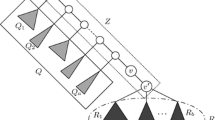Abstract
A procedure is given for finding the independent sets in an undirected graph by xeroxing onto transparent plastic sheets. Let an undirected graph having n vertices and m edges be given. A list of all the independent subsets of the set of vertices of the graph is constructed by using a xerox machine in a manner that requires the formation of only n + m + 1 successive transparencies. An accompanying list of the counts of the elements in each independent set is then constructed using only O(n 2) additional transparencies. The list with counts provides a list of all maximum independent sets. This gives an O(n 2) step solution for the classical problem of finding the cardinality of a maximal independent set in a graph. The applicability of these procedures is limited, of course, by the increase in the information density on the transparencies when n is large. Our ultimate purpose here is to give hand tested ‘ultra parallel’ algorithmic procedures that may prove suitable for realization using future optical technologies.






Similar content being viewed by others
References
Garey MR, Johnson DS (1979) Computers and intractability—a guide to the theory of NP-completeness. W.H. Freeman & Co, San Francisco
Grandin T (1995) Thinking in pictures and other reports from my life with autism. Vintage Books, New York
Head T (2007) Photocomputing: explorations with transparency & opacity. Parallel Process Lett 17:339–347
Head T (2009) Parallel computing by xeroxing onto transparencies. In: Condon A, Harel D, Kok JN, Salomaa A, Winfree E (eds) Algorithmic bioprocesses. Springer-Verlag, Heidelberg, pp 631–637
Head T, Gal S (2006) Aqueous computing: writing on molecules dissolved in water. In: Chen J, Jonoska N, Rozenberg G (eds) Nanotechnology: science and computation. Springer, Heidelberg, pp 321–331
Head T, Rozenberg G, Bladergroen R, Breek CKD, Lomerese PHM, Spaink H (2000) Computing with DNA by operating on plasmids. Bio Syst 57:87–93
Louri A (1992) Optical content-addressable parallel processor: architecture, algorithms, and design concepts. Appl Opt 31:3241–3258
Naor M, Shamir A (1995) Visual cryptography. In: Eurocrypt ‘94, vol 950. LNCS, pp 1–12
Oltean M (2008) Solving the Hamiltonian path problem with a light based computer. Nat Comput 6:57–70
Ouyang Q, Kaplan PD, Liu S, Libchaber A (1997) DNA solutions of the maximal clique problem. Science 278:446–449
Schulte D (2005) Rainbow sort: sorting at the speed of light. Nat Comput 5:67–82
Author information
Authors and Affiliations
Corresponding author
Rights and permissions
About this article
Cite this article
Head, T. Computing transparently: the independent sets in a graph. Nat Comput 10, 129–138 (2011). https://doi.org/10.1007/s11047-010-9186-0
Published:
Issue Date:
DOI: https://doi.org/10.1007/s11047-010-9186-0




